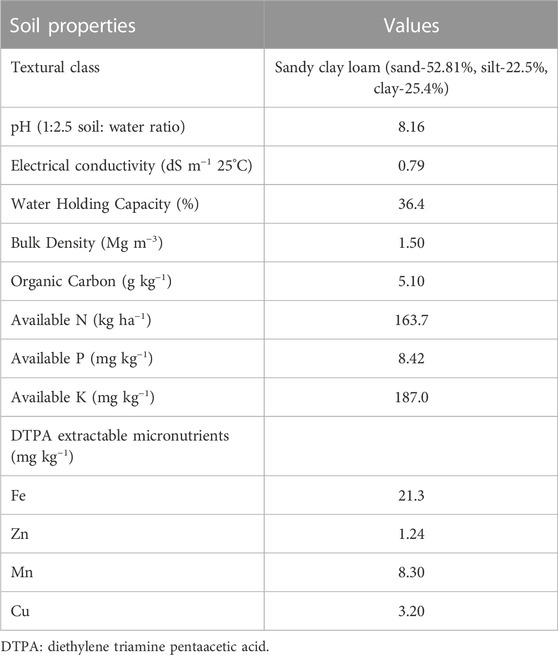- 1Division of Agronomy, ICAR-Indian Agricultural Research Institute, New Delhi, India
- 2ICAR-Indian Institute of Soil and Water Conservation, Research Centre, Kota, Rajasthan, India
- 3Centre for Environment Science and Climate Resilient Agriculture, Indian Agricultural Research Institute, New Delhi, India
- 4ICAR-Indian Institute of Soil and Water Conservation, Dehradun, Uttarakhand, India
Healthy soils are the foundation for producing healthy food and creating a healthy environment. Therefore, we assessed the changes in the physical and chemical properties of soil, and their long-term impact on yield, quality, and nutritional status of rice grains in an organic basmati rice-based cropping system in a typic Ustchrept Soil of India. The experiment was laid out in a strip plot design with three replications. The vertical strips consisted of two rice-based cropping systems, namely, basmati rice-wheat-mung bean (RWM) and basmati rice-wheat-sesbania (RWS), whereas seven combinations of different organic materials and biofertilizers (BF) were assigned to horizontal strips, viz., control (no manure application), farmyard manure (FYM), vermicompost (VC), FYM + crop residues (CR), VC + CR, FYM + CR + BF, and VC + CR + BF. The results revealed that soil moisture content (SMC), soil organic carbon (SOC), soil total N, and soil available P, Fe, Zn, Mn, and Cu were significantly higher under the RWS system than in RWM. The application of organic manures either alone or in conjunction with CR and BF significantly lowered the soil pH (∼3.0%), EC (43.1%–45.8%), and BD (3.3%–9.2%) as compared to the control. Water holding capacity (WHC), SMC, and SOC were increased by 5.7%–14.7%, 8.7%–49.3%, and 35.3%–76.5%, respectively under single or co-application of FYM/VC with CRs and BFs as compared to control. Similarly, sole or conjoint application of organic manures, CR, and BF significantly enhanced the soil available macro (N, P, and K) and micro (Fe, Zn, Mn, and Cu) nutrients over the control. Grain yield, protein content, N uptake, and cooking quality parameters were significantly higher under the RWS system than under RWM. However, the Zn concentration and its uptake by grains were significantly higher under the RWM system over RWS. The grain yield was significantly increased by 25.8%–49.2% under different organic nutrient management options over control. The single or conjoint application of FYM/VC with CR and BF increased the hulling, milling, head rice recovery, and protein concentration in grain by 9.4%–9.8%, 23.2%–28.4%, 22.7%–25.5%, and 9.6%–10.7%, respectively over control. The concentration of N, P, K, Fe, Zn, Mn, and Cu was significantly improved by 9.7%–11.3%, 45.5%–63.6%, 16.7%–20.8%, 66.9%–74.1%, 72.9%–81.9%, 87.1%–97.0%, and 48.9%–67.2%, respectively under co-application of FYM/VC with CR and BF compared to control. Thus, our results indicate that improved soil properties could significantly increase the physical and nutritional quality of basmati rice grain. Therefore, adopting basmati rice-based cropping systems with different organic nutrient sources can sustain soil health, end global hunger, produce nutritious food, and create a healthy environment.
1 Introduction
Soil is a complex, heterogeneous, and non-renewable natural resource that provides fundamental ecosystem services for living beings (Brevik et al., 2020). It is a medium for plant growth and food production, a recycling hub for nutrients and organic matter, a habitat for soil microorganisms, a foundation for infrastructures, and a system for water supply and purification (Abrahams, 2002; Zornoza et al., 2015). Despite the fundamental services being provided by soil, unsustainable land use patterns caused widespread degradation of agricultural soils via loss of organic carbon, compaction, salinization, contamination, nutrient exhaustion, structural deterioration, etc., (Kibblewhite et al., 2008). Hence, the preservation of soil fertility and its health is crucial for sustainable food production. Moreover, soil health is directly or indirectly related to human health. Directly by the inhalation, ingestion, and absorption of the soil and indirectly through the quality and quantity of food produced from the soil (Brevik, 2009; Oliver and Gregory, 2015; Steffan et al., 2018). Therefore, the restoration and maintenance of soil health poses greater importance for the supply of essential nutrients, improves the immune system, and enhances human health.
Nutrient sufficiency is imperative for the good health, longevity of life, and productive lives of plants, animals, and human beings. The primary source of nutrient availability to people is the food produced from soil (Welch, 2002; Shrestha et al., 2020). If soils fail to produce quality food to fulfill the nutritional requirements of human beings, people’s health will deteriorate and it will also affect national development. The global yields of staple food grains significantly increased during the 1960s. However, the pace between growth in calorie productivity and the production of nutrients needed for a balanced human diet has been ignored (Steffan et al., 2018). Moreover, it has been documented that climate change-induced increased atmospheric CO2 concentration will further restrict the nutrient concentration in crops and alter the protein content, vitamins, and nutrients content in crops (Myers et al., 2014; Zhu et al., 2018). Hence, nutritional security together with sustainable soil health will be the greatest challenge to future food production systems.
The decreasing nutrient concentration in crops is a global threat and raised concerns about nutrient deficiency or hidden hunger (Dhaliwal et al., 2019a). Worldwide, more than 2.0 billion people are suffering from hidden hunger or multiple nutrient deficiencies that cause serious health issues, especially in children and pregnant women (Pirzadeh et al., 2010; Detterbeck et al., 2016; Brevik et al., 2020). Today, more focus is given to dietary supplementation than to enriching existing food crops through soil management. There are approximately 17 elements derived from the soil that are indispensable for crop growth and productivity, and most of these are also necessary for human health (Bala et al., 2018; Huang et al., 2020; Agyin-Birikorang et al., 2022). These nutrients are consumed by people through the direct consumption of plant-based diets (Abrahams, 2002). Therefore, restoration and management of soil health are important to supply essential nutrients to crops and to produce nutrient-rich good quality food.
Rice is one of the most important staple food crops, safeguarding the food and nutritional security of the world (Fukagawa and Ziska, 2019; Huang et al., 2020; Khanam et al., 2020). Nutrient deficiency is predominant in people who solely consume rice in their diet; and rice being one of the main foods consumed worldwide, its importance with respect to nutrition and human health remains a keen area of interest. However, the adoption of intensive cropping systems with imbalanced fertilizer application and lower use of organic manures depleted organic matter and induced macro and micronutrient deficiencies (Dhaliwal et al., 2019a; Brevik et al., 2020). This jeopardizes the potential and capacity of soil to fulfill the nutritional demand of future generations. It has been documented that intensive cropping systems caused an initial Zn deficiency and a later Fe and Mn deficiency in many agricultural land use systems (Dhaliwal et al., 2019a). Globally, approximately 50% of cereal-producing soils have low Zn availability, indicating an urgent need for replenishment of Zn and other microelements in cereal-centric systems (Cakmak, 2008). Organic agriculture is a holistic strategy to restore soil fertility, improve soil properties, including the build-up of soil organic matter (SOM), and enhance nutrient uptake and concentration in grains. The inclusion of legumes as green manure in the rice-wheat cropping system has been reported to improve soil physicochemical properties, macro, and micronutrients availability in the soil, and uptake by crops (Dhaliwal et al., 2019a; Dhaliwal et al., 2019b). The application of organic manure has been found to improve soil health and enhance the availability of primary (N, P, and K) and micronutrients (Zn, Fe, Cu, and Mn) in the soil (Dhaliwal and Walia, 2008; Dhaliwal et al., 2019a). Rutkowska et al. (2014) observed a significant effect of long-term mineral fertilizers and organic manures on pH, SOM, and available macro and micronutrients. The absorption of nutrients by the crops depends on the availability of nutrients in the soil pool, which is controlled by soil physicochemical and biological properties (Dhaliwal et al., 2019b). Organic nutrients-based management practice is an environment-friendly and economically viable agronomic approach. It is a potential way to achieve soil and nutritional security and sustainable development goals (SDGs) of the United Nations. Therefore, the present study was undertaken in a 16-year-old organic rice-based cropping system with the hypothesis that implementation of organic nutrient management in the rice-based system might lead to improvements in soil physicochemical environment and SOC, and thereby, lead to a higher nutrient concentration in rice grains. The objectives of this research were to appraise the effect of organic nutrient sources on soil physicochemical properties, SOC, grain yield, nutrient uptake by crop, and grain quality.
2 Materials and methods
2.1 Site description and meteorological characteristics
The study area was located at the research farm of the ICAR-Indian Agricultural Research Institute (IARI), New Delhi, India. The altitude of the experimental site is 250 m above the mean sea level with 28.4°N latitude and 77.1°E longitude. The climate of the region is semiarid categorized under the subtropical zone, having hot summers and cold winters, with an average annual rainfall of 750 mm, most of which occurs during the rainy season (July to September), and average annual pan evaporation of 850 mm. The climatic variables recorded during the experimental period were collected from the Agrometeorological observatory of the ICAR-IARI, New Delhi and are depicted in Figure 1. The mean maximum and minimum temperatures during the crop-growing season were 34.8°C and 25.4°C, respectively. The total rainfall received during the field experimentation was 1,413.7 mm. The present research was carried out in a 16-year-old organic field experiment at the ICAR-IARI, New Delhi, India. This experiment on basmati rice-based cropping systems under organic cultivation was started in 2003. The initial period from 2003 to 2005 was considered a transitional period and from 2006 onwards, the true organic field experiment was started. Different rice-based cropping systems with or without legumes were followed at the experimental site before the present investigation (Supplementary Table S1). The soil (Typic Ustochrept) of the research site is non-saline having a sandy clayey loam texture (Bouyoucos, 1962). The basic physicochemical properties of the soil at the beginning of the experiment are shown in Table 1.
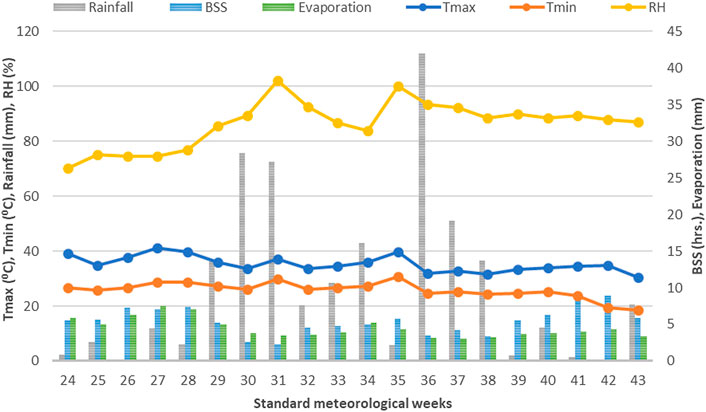
FIGURE 1. Average weekly rainfall, Tmax, Tmin, RH, evaporation, and BSS during crop growing season. Tmax: maximum temperature; Tmin: minimum temperature; RH: relative humidity; and BSS: bright sunshine hours season.
2.2 Experimental design and treatment details
The experiment was laid out in a split-block or strip plot design with three replications (Supplementary Table S2). The vertical strips consisted of two rice-based cropping systems, namely, basmati rice-wheat-mung bean (RWM) and basmati rice-wheat-sesbania (RWS), whereas seven combinations of different organic materials and biofertilizers (BF) were assigned to horizontal strips viz., 1. control, 2. farmyard manure (FYM) equivalent to 80 kg N ha−1, 3. vermicompost (VC) equivalent to 80 kg N ha−1, 4. FYM + crop residue (CR) of the previous crop at a rate of 2.5 t ha−1 for each rice and wheat, 5.VC + CR, 6. FYM + CR + BF, and 7. VC + CR + BF (Supplementary Table S3). Sesbania was cultivated as a green manure crop, while mung bean was raised as green manure as well as for grain purposes. The varieties Pusa basmati 1,692, Pusa Vishal, and Sesbania sp. were used for rice, mung bean, and sesbania, respectively. Biofertilizers viz., Azospirillum, phosphate solubilizing bacteria (PSB), potassium solubilizing bacteria (KSB), and Cellulolytic culture (Aspergillus awamori, Trichoderma viride, Phanerochaete chrysosporuim, and Aspergillus wolulens) were used for rice, while Azotobacter, PSB, KSB, and Cellulolytic culture in wheat and Rhizobium, PSB and KSB in mung bean/sesbania were applied. The cellulolytic culture was used only in the crop residue applied treatments (Supplementary Table S2).
2.3 Experimental methods for soil and plant samples
The soil samples were collected randomly from three places in each treatment from the plow layer (0–15 cm) of the soil after the crop harvest. The air-dried samples were processed and analyzed for different physical and chemical soil properties. The core sampler method was used to determine the soil bulk density (BD) and expressed as Mg m–3 (Hartge and Blake, 1986). Soil pH and electrical conductivity (EC) were determined through the 1:2.5 soil: water suspension method described by Jackson (1973). The water holding capacity (WHC) of soil was measured by the method described by Keen and Raczkowski (1921). Soil moisture content (SMC) was determined via the gravimetric method at 0–15 cm soil depth. The SOC was measured by the rapid titration method given by Walkley and Black (1934). Soil available N was determined by the alkaline permanganate (KMnO4) method developed by Subbiah and Asija (1956). Available P by 0.5 M sodium bicarbonate (NaHCO3) having pH 8.5 (Olsen et al., 1954) and 1 N neutral ammonium acetate (NH4OAc-K) method was used to extract available K (Jackson, 1973). Soil-available micronutrients (Fe, Zn, Mn, and Cu) were determined by the diethylenetriamine pentaacetic acid (DTPA) developed by Lindsay and Norvell (1978). SOC stock was calculated by using the following equation (Datta et al., 2015):
Where, SOC stock was expressed as Mg ha−1, OC is the SOC content (g C kg−1), BD is bulk density (Mg m−3), soil depth in m (0.15 m), and area in m2 (10,000 m2).
The grain yield was recorded from 2 m × 2 m from each plot and expressed as t ha−1 at a 12% moisture level. Hulling, milling, and head rice recovery (HRR) were calculated by using the following formulas:
Ten milled grains before cooking were randomly selected and used for measuring length and breadth on graph paper using a “Photo Enlarger” with a magnification of ×3. The actual mean of grain length and breadth was expressed in mm. The same procedure was also followed for the length and breadth measurement of rice grain after boiling it in a water bath (Thermotech temperature controller TH-013) for 8–10 min. The modified Kjeldahl method was used to measure the total N concentration in rice grain (Prasad et al., 2006). A coefficient factor of 5.95 was used to determine the crude protein (CP) content of rice grain, which was obtained by multiplying grain N concentration with the factor (Juliano, 1985). Total P and K in rice grains were estimated by the Vanado-molybdo phosphoric acid yellow color method and the flame photometry method, respectively, on a sulfuric-nitric perchloric tri-acid digest of plant material (Prasad et al., 2006). The micronutrient (Fe, Zn, Mn, and Cu) concentration in rice grains was determined by a wet-digestion (di-acid digestion) procedure on an anatomic absorption spectrophotometer (Prasad et al., 2006).
2.4 Statistical analysis
All the experimental data pertaining to soil properties and crop quality were statistically assessed using the analysis of variance (ANOVA) in SAS 9.3 software (SAS Institute Inc., Cary, NC, United States). The significance of treatment means was tested using the F–test (Gomez and Gomez 1984). The least significant difference (LSD) was worked at a 5% (p = 0.05) level of significance to evaluate differences between treatment means. A Pearson’s correlation matrix was constructed among the soil properties and plant nutrients status studied using the data analysis tool pack of Microsoft Excel (2007).
3 Results
3.1 Soil properties influenced by cropping systems and nutrient management
3.1.1 Soil pH
Basmati rice-based cropping systems under organic agriculture registered no significant effect on soil pH at 0–15 cm soil profile (Figure 2). However, the continuous application of organic manures either alone or in combination with CR and BF showed a statistically significant (p ≤ 0.05) effect on soil pH. The trend for soil pH under varied nutrient management treatments was CT > VC > FYM > VC + CR > FYM + CR > VC + CR + BF > FYM + CR + BF. The lowest soil pH of 7.98 recorded under FYM + CR + BF, was approximately 3.0% lower than that of the control. Thus, the incorporation of organic manures either alone or via conjoint application was found to be superior in reducing soil pH relative to the control.
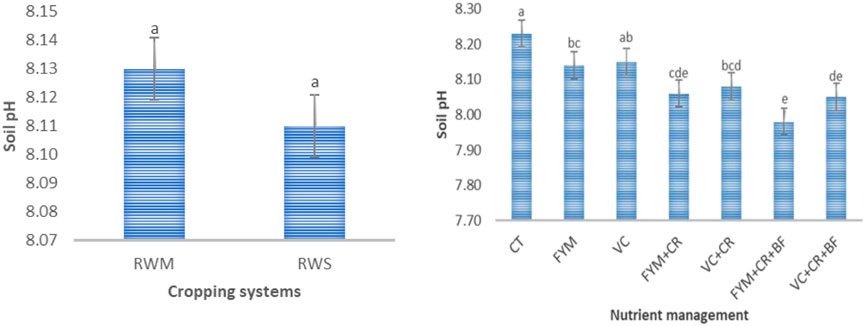
FIGURE 2. Long-term effect of cropping systems and organic nutrient management on soil pH. RWM: rice-wheat-mung bean; RWS: rice-wheat-sesbania; CT: control; FYM: farm yard manure; VC: vermicompost; CR: crop residue(s); and BF: biofertilizer(s). Statistical method: analysis of variance for strip-plot design in SAS 9.3 software; n = 42. Values with a different capital letter indicate a significant difference among the different treatments at p < 0.05 by the LSD test. Bars represent means ± SEM.
3.2 Electrical conductivity
The electrical conductivity (EC) of the soil at 0–15 cm soil depth under rice-based cropping systems was not significantly affected. However, EC under different organic nutrient management was significantly varied (Figure 3). The EC under different nutrient management treatments was in the order of CT > FYM > VC > VC + CR > FYM + CR > VC + CR + BF > FYM + CR + BF. The application of FYM and VC significantly (p ≤ 0.05) decreased the EC by 27.8% and 36.1%, respectively in comparison to the control. A significant (p ≤ 0.05) reduction of 40.3%–45.8% in soil EC was also observed under conjoint application of FYM/VC with CR and BF to the control.
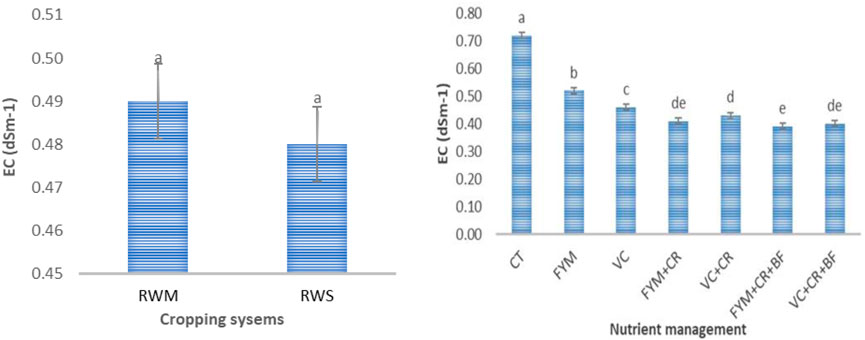
FIGURE 3. Long-term effect of cropping systems and organic nutrient management on soil EC. EC: electrical conductivity; RWM: rice-wheat-mung bean; RWS: rice-wheat-sesbania; CT: control; FYM: farm yard manure; VC: vermicompost; CR: crop residue(s); and BF: biofertilizer(s). Statistical method: analysis of variance for strip-plot design in SAS 9.3 software; n = 42. Values with a different capital letter indicate a significant difference among the different treatments at p < 0.05 by the LSD test. Bars represent means ± SEM.
3.3 Bulk density
The soil bulk density (BD) at 0–15 cm depth was found non-significant under organic basmati rice-based cropping systems. However, the BD was statistically significant (p ≤ 0.05) under varied nutrient management options (Figure 4). The sole or co-application of organic manures with CR and BF decreased the BD by 3.3%–9.2% relative to the control. The lowest BD of 1.39 Mg m−3 was observed in VC + CR + BF treatment while the highest was seen in the control (1.53 Mg m−3)
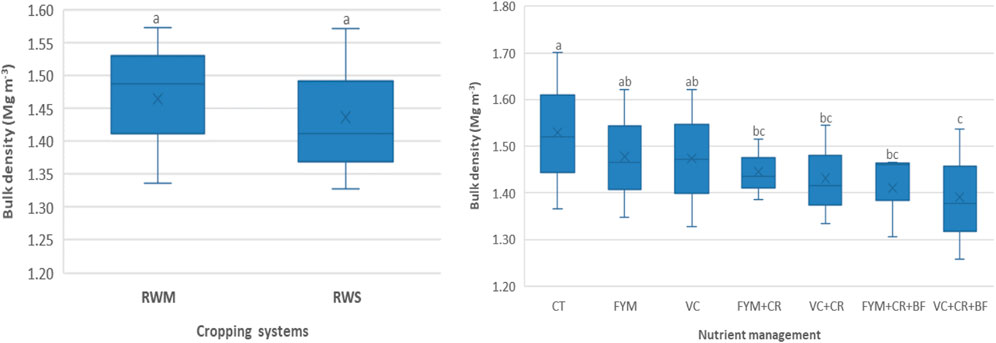
FIGURE 4. Long-term effect of cropping systems and organic nutrient management on soil BD. BD: bulk density; RWM: rice-wheat-mung bean; RWS: rice-wheat-sesbania; CT: control; FYM: farm yard manure; VC: vermicompost; CR: crop residue(s); and BF: biofertilizer(s). Statistical method: analysis of variance for strip-plot design in SAS 9.3 software; n = 42. Values with a different capital letter indicate a significant difference among the different treatments at p < 0.05 by the LSD test. Bars represent means ± SEM.
3.4 Water holding capacity
Basmati rice-based cropping systems registered a significant effect on the water-holding capacity (WHC) of soil (Figure 5). The inclusion of sesbania as a green manure crop in the rice-based system recorded higher WHC (54.9%) as compared to the RWM system (52.8%). However, the addition of organic manures either alone or in conjunction with CR and BF showed significant (p ≤ 0.05) improvement in WHC over the control. The maximum WHC was found in FYM + CR + BF (56.7%) followed by VC + CR + BF (55.4%) and FYM + CR (54.9%). The application of FYM alone or in combination with CR and BF was found superior over VC-based treatments. The trend was FYM + CR + BF > VC + CR + BF > FYM + CR > VC + CR > FYM > VC > CT under varied nutrient management options.
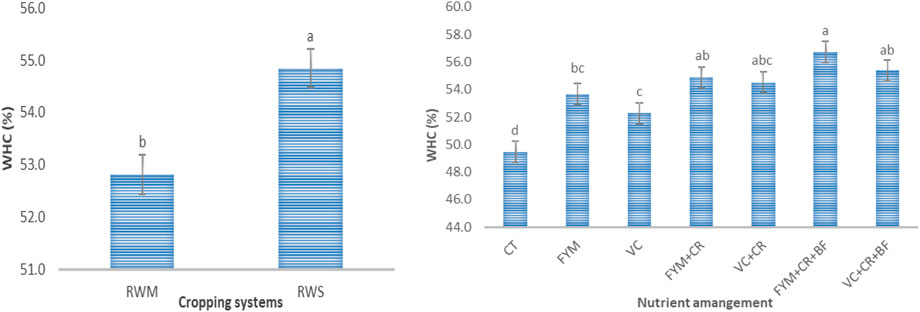
FIGURE 5. Long-term effect of cropping systems and organic nutrient management on WHC. WHC: water holding capacity; RWM: rice-wheat-mung bean; RWS: rice-wheat-sesbania; CT: control; FYM: farm yard manure; VC: vermicompost; CR: crop residue(s); and BF: biofertilizer(s). Statistical method: analysis of variance for strip-plot design in SAS 9.3 software; n = 42. Values with a different capital letter indicate a significant difference among the different treatments at p < 0.05 by the LSD test. Bars represent means ± SEM.
3.5 Soil moisture content
The effect of rice-based cropping systems and different organic nutrient sources on gravimetric soil moisture content (SMC) was found significant (p ≤ 0.05) at 0–15 cm soil depth (Figure 6). The inclusion of sesbania as a green manure crop in the rice-based system conserved 5.5% higher SMC as compared to the RWM system. Among the nutrient management, the application of organic manures either alone or in combination with CR and BF recorded greater SMC over the control. The highest SMC of 26.6% was observed in FYM + CR + BF being closely followed by VC + CR + BF (25.7%). The minimum SMC was recorded in the control. The trend of SMC was FYM + CR + BF > VC + CR + BF > FYM + CR > VC + CR > FYM > CT under different nutrient management options.

FIGURE 6. Long-term effect of cropping systems and organic nutrient management on SMC. SMC: soil moisture content; RWM: rice-wheat-mung bean; RWS: rice-wheat-sesbania; CT: control; FYM: farm yard manure; VC: vermicompost; CR: crop residue(s); and BF: biofertilizer(s). Statistical method: analysis of variance for strip-plot design in SAS 9.3 software; n = 42. Values with a different capital letter indicate a significant difference among the different treatments at p < 0.05 by the LSD test. Bars represent means ± SEM.
3.6 Soil organic carbon (SOC) and SOC stock
The SOC and SOC stock were significantly (p ≤ 0.05) affected by basmati rice-based cropping systems in 0–15 cm soil depth. The highest SOC and its stock were recorded under RWS (Figure 7). The application of organic manures alone or in conjunction with CR and BF showed significant (p ≤ 0.05) improvement in SOC and its stock over control (Figure 7). The SOC content and its stock were significantly (p ≤ 0.05) increased by 35.3%–76.5% and 29.5%–72.0%, respectively under sole or conjoint application of organic manures as compared to the control. The maximum SOC and its stock were observed in VC + CR + BF. The lowest SOC (4.9 g kg−1 soil) and SOC stock (11.4 Mg ha−1) were recorded in the control.
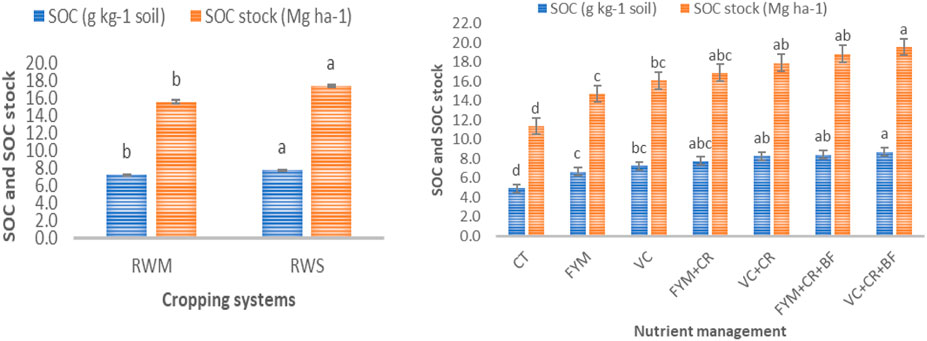
FIGURE 7. Long-term effect of cropping systems and organic nutrient management on SOC and SOC stock. SOC: soil organic carbon; RWM: rice-wheat-mung bean; RWS: rice-wheat-sesbania; CT: control; FYM: farm yard manure; VC: vermicompost; CR: crop residue(s); and BF: biofertilizer(s). Statistical method: analysis of variance for strip-plot design in SAS 9.3 software; n = 42. Values with a different capital letter indicate a significant difference among the different treatments at p < 0.05 by the LSD test. Bars represent means ± SEM.
3.7 Soil available N, P, and K
The effect of basmati rice-based cropping systems on soil available N and K was not significant (Figure 8). However, the soil available P was significant (p ≤ 0.05). The maximum soil available N and P were observed under the RWS system. The inclusion of mung bean in the rice-based system recorded maximum soil available K. Among the nutrient management options, the application of organic manures either alone or in combination with CR and BF was found statistically significant (p ≤ 0.05) for soil available N, P, and K content. The application of organic manures recorded greater soil available N, P, and K content than the control (Figure 8). The application of organic manures improved the soil available N by 28.4%–62.8% relative to the control. The single or conjoint application of organic manures enhanced the soil available P by 1.6–2.5 times relative to the control. Similarly, the application of organic manures either alone or in combination with CR and BF improved the soil available K. The maximum soil available K was recorded in VC + CR + BF, which was at par with the FYM + CR + BF. The application of organic manures increased the soil available K by 20.1%–58.8% over the control. The lowest soil available N, P, and K content were observed in the control.
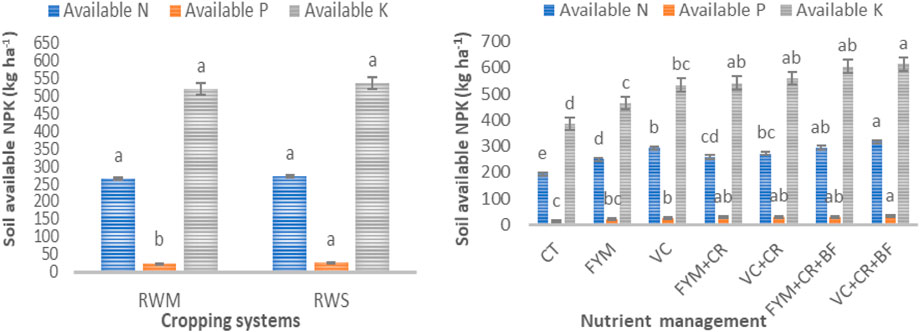
FIGURE 8. Long-term effect of cropping systems and organic nutrient management on soil available N, P, and K. RWM: rice-wheat-mung bean; RWS: rice-wheat-sesbania; CT: control; FYM: farm yard manure; VC: vermicompost; CR: crop residue(s); and BF: biofertilizer(s). Statistical method: analysis of variance for strip-plot design in SAS 9.3 software; n = 42. Values with a different capital letter indicate a significant difference among the different treatments at p < 0.05 by the LSD test. Bars represent means ± SEM.
3.8 Soil total nitrogen
The inclusion of legumes (sesbania and mung bean) in the basmati rice-wheat cropping system significantly (p ≤ 0.05) influenced the total N content of the soil (Figure 9). The highest total N content (1.94 g kg−1 soil) in the soil was found under the RWS system, which was 18.3% greater than the RWM system. Similarly, the single or conjoint application of organic manures with CR and BF significantly (p ≤ 0.05) improved the soil’s total nitrogen content (Figure 9). The total soil N content was increased by 15.4%–55.2% under varied nutrient management options relative to the control. The highest total soil N content was recorded in VC + CR + BF (2.22 g kg−1 soil) followed by VC + CR (1.92 g kg−1 soil) and FYM + CR + BF (1.91 g kg−1 soil). The lowest total N content in the soil was found in the control.

FIGURE 9. Long-term effect of cropping systems and organic nutrient management on soil total N. RWM: rice-wheat-mung bean; RWS: rice-wheat-sesbania; CT: control; FYM: farm yard manure; VC: vermicompost; CR: crop residue(s); and BF: biofertilizer(s). Statistical method: analysis of variance for strip-plot design in SAS 9.3 software; n = 42. Values with a different capital letter indicate a significant difference among the different treatments at p < 0.05 by the LSD test. Bars represent means ± SEM.
3.9 Soil available micronutrients (Fe, Zn, Mn, and Cu)
The availability of micronutrients, namely, Fe, Zn, Mn, and Cu, in the soil was found significantly (p ≤ 0.05) different under basmati rice-based cropping systems (Figure 10). The maximum soil available Fe (32.7 mg kg−1 soil), Zn (2.8 mg kg−1 soil), Mn (13.5 mg kg−1 soil), and Cu (4.3 mg kg−1 soil) were observed under the RWS system. Among the nutrient management options, the application of organic manures either alone or in combination with CR and BF significantly (p ≤ 0.05) affected the soil available Fe, Zn, Mn, and Cu content over control (Figure 10). The maximum soil available Fe and Zn contents were recorded in FYM + CR + BF, which was at par with the application of VC + CR + BF. The application of organic manures improved the soil available Fe and Zn by 17.4%–44.1% and 12.3%–41.0%, respectively as compared to the control. Treatments comprised of FYM alone or in combination with CR and BF recorded a higher magnitude of soil available Fe and Zn than VC treatments. However, the maximum soil available Mn and Cu contents were observed in VC + CR + BF as compared to the rest of the treatments. The application of organic manures improved the soil available Mn and Cu content by 22.1%–55.2% and 19.0%–66.5%, respectively over the control. Treatments comprised of VC alone or in combination with CR and BF recorded higher soil available Mn and Cu than FYM treatments. The lowest soil available Fe, Zn, Mn, and Cu contents were recorded in the control.
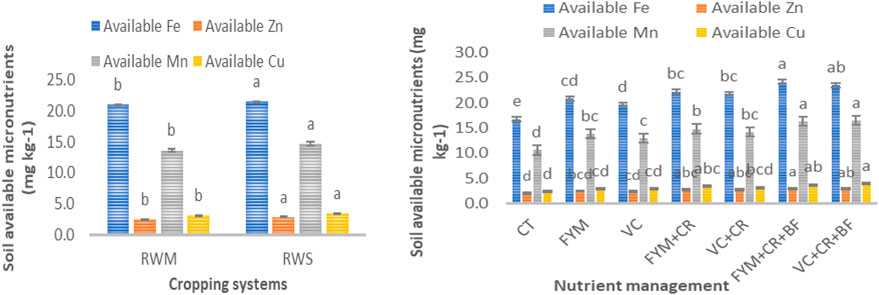
FIGURE 10. Long-term effect of cropping systems and organic nutrient management on soil available Fe, Zn, Mn, and Cu. RWM: rice-wheat-mung bean; RWS: rice-wheat-sesbania; CT: control; FYM: farm yard manure; VC: vermicompost; CR: crop residue(s); and BF: biofertilizer(s). Statistical method: analysis of variance for strip-plot design in SAS 9.3 software; n = 42. Values with a different capital letter indicate a significant difference among the different treatments at p < 0.05 by the LSD test. Bars represent means ± SEM.
3.10 Crop productivity, grain quality, and nutrients concentration in grain
3.10.1 Grain yield, kernel length, breadth, and protein content
Grain yield, kernel length before cooking (KLBC), kernel length-breadth ratio before cooking (KLBRBC), kernel length-breadth ratio after cooking (KLBRAC), and protein concentration of basmati rice were significantly (p ≤ 0.05) influenced by rice-based cropping systems (Table 2). The inclusion of sesbania as green manure in the rice-wheat system recorded significantly higher grain yield, KLBC, KLBRBC, KLBRAC, and protein content than the RWM system. Among the nutrient management options, either single or conjoint application of organic manures significantly (p ≤ 0.05) improved the grain yield and kernel quality characters viz., KLBC, kernel breadth before cooking (KBBC), KLBRBC, kernel length after cooking (KLAC), kernel breadth after cooking (KBAC) KLBRAC, and protein content of basmati rice (Table 2). The highest grain yield was recorded in VC + CR + BF, which was statistically equivalent to FYM + CR + BF. The application of organic manures either alone or in combination with CR and BF enhanced the grain yield by 25.8%–49.2% as compared to the control. The highest KLBC was recorded in VC + CR + BF, which was statistically equivalent to FYM + CR + BF and VC + CR. A similar trend was also observed in the case of KBBC and KLBRBC. Similarly, the continuous application of VC + CR + BF recorded the highest KLAC, KBAC, and KLBRAC, which was closely followed by FYM + CR + BF, VC + CR, and FYM + CR. The application of organic manures increased the protein concentration in grain by up to 10.7% as compared to the control. The maximum protein content was recorded in VC + CR + BF, which was statistically equivalent to FYM + CR + BF and VC + CR.
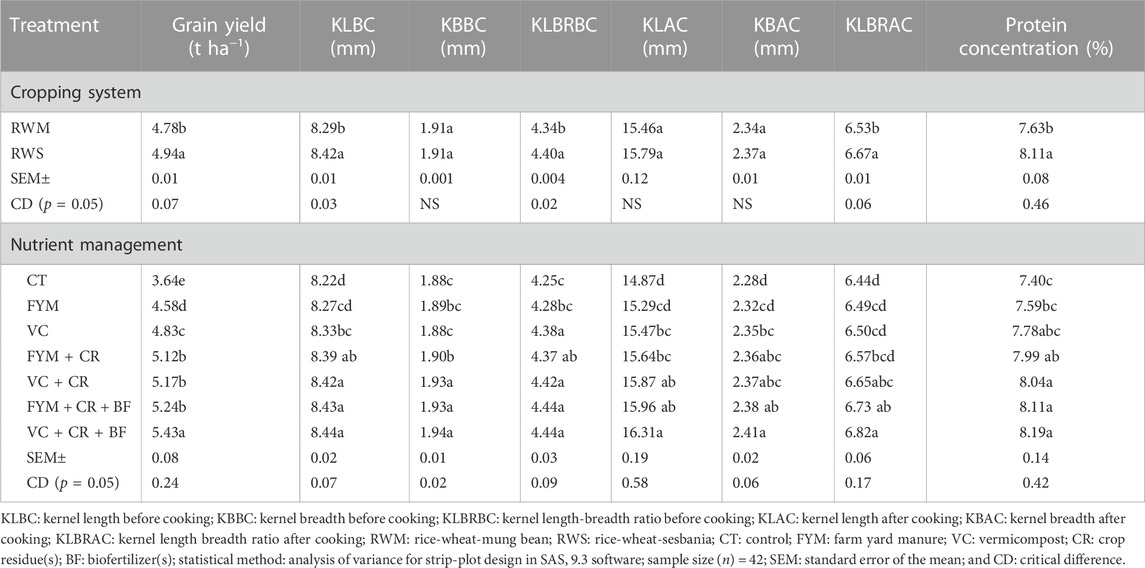
TABLE 2. Long-term effect of cropping systems and organic nutrient management on kernel length, breadth, and protein content of basmati rice.
3.11 Hulling, milling, and head rice recovery
The inclusion of legumes in the basmati rice-based cropping system had no significant effect on hulling, milling, and head rice recovery (HRR) of rice (Figure 11). However, the effect of the continuous application of various organic manures on hulling, milling, and HRR of basmati rice was found statistically significant (p ≤ 0.05) (Figure 11). The highest hulling, milling, and HRR were recorded in VC + CR + BF. The conjoint application of organic manure with CR and BF improved the hulling, milling, and HRR of basmati rice by 6.8%–9.8%, 5.3%–28.5%, and 13.2%–25.5%, respectively as compared to the control. The trend for hulling, milling, and HRR was VC + CR + BF > FYM + CR + BF > VC + CR > FYM + CR > VC > FYM > CT. The lowest hulling, milling, and HRR were recorded in the control.
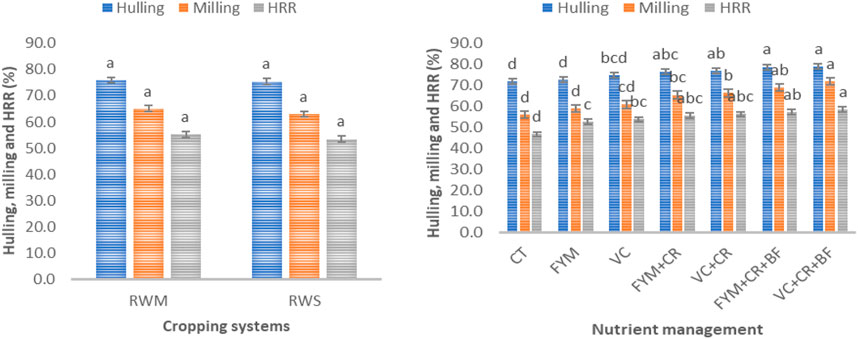
FIGURE 11. Long-term effect of cropping systems and organic nutrient management on hulling, milling, and HRR. HRR: head rice recovery; RWM: rice-wheat-mung bean; RWS: rice-wheat-sesbania; CT: control; FYM: farm yard manure; VC: vermicompost; CR: crop residue(s); and BF: biofertilizer(s). Statistical method: analysis of variance for strip-plot design in SAS 9.3 software; n = 42. Values with a different capital letter indicate a significant difference among the different treatments at p < 0.05 by the LSD test. Bars represent means ± SEM.
3.12 N, P, and K concentrations and their uptake by grain
The N concentration and its uptake into rice grain were found statistically significant (p ≤ 0.05) under legume-inclusive basmati rice-based cropping systems (Table 3). However, the effect of basmati rice-based cropping systems on P and K concentrations and their uptake into grain were not significant (Table 3). The highest N concentration and its uptake into rice grain were observed in the RWS system. Among the nutrient management options, the continuous application of different organic manures showed a statistically significant (p ≤ 0.05) effect on N, P, and K concentrations and their uptake into the grain (Table 3). The N content and its uptake into grain were significantly increased by 3.2%–11.3% and 29.1%–64.8%, respectively under various nutrient management options over the control. The continuous application of VC + CR + BF registered the highest P concentration and its uptake into the grain. The P uptake into grain under different nutrient management treatments was increased by 38.3%–133.0% relative to the control. Similarly, the application of VC + CR + BF registered the highest K content and its uptake into the grain. The K concentration and its uptake into grain were enhanced by 4.2%–20.8% and 31.1%–78.7%, respectively than that of the control. The lowest N, P, and K contents in grain and their uptake into grain were recorded in the control.
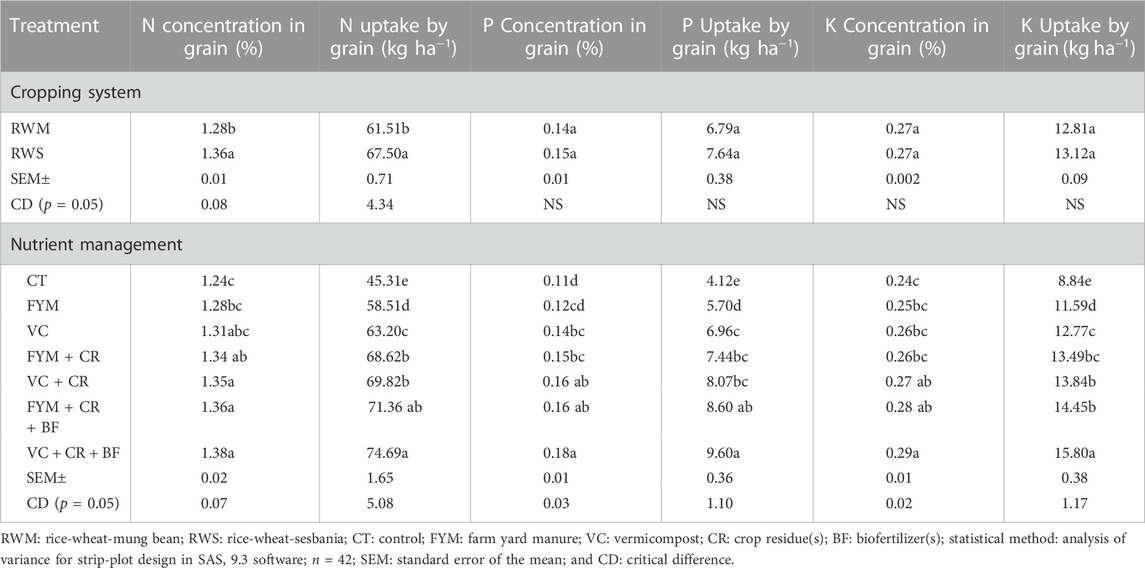
TABLE 3. Long-term effect of cropping systems and organic nutrient management on N, P, and K concentrations and their uptake by rice grain.
3.13 Fe, Zn, and Cu concentrations and their uptake by grain
The legume-inclusive basmati rice-based cropping systems affect Zn concentrations in the grain (Table 4); however, no effects were observed on Fe, Mn, and Cu concentrations. The highest Zn concentration and its uptake by grain were observed in the RWS system. Among the nutrient management options, the continuous application of different organic manures showed a statistically significant (p ≤ 0.05) effect on Fe, Zn, Mn, and Cu concentrations and their uptake into the grain (Table 4). The highest Fe and Zn concentrations and uptake by grains were recorded in FYM + CR + BF, being statistically equivalent to VC + CR + BF. The concentrations of Fe and Zn in rice grains under varied nutrient management treatments were increased by 11.9%–74.1% and 15.9%–81.9%, respectively over the control. Similarly, the uptakes of Fe and Zn were enhanced by 44.8%–149.9% and 49.9%–159.2%, respectively. The concentrations of Mn and Cu under various nutrient management treatments were improved by 23.4%–97.0% and 13.6%–67.2%, respectively relative to the control. The lowest Fe, Zn, Mn, and Cu contents and uptake into grain were recorded in the control.
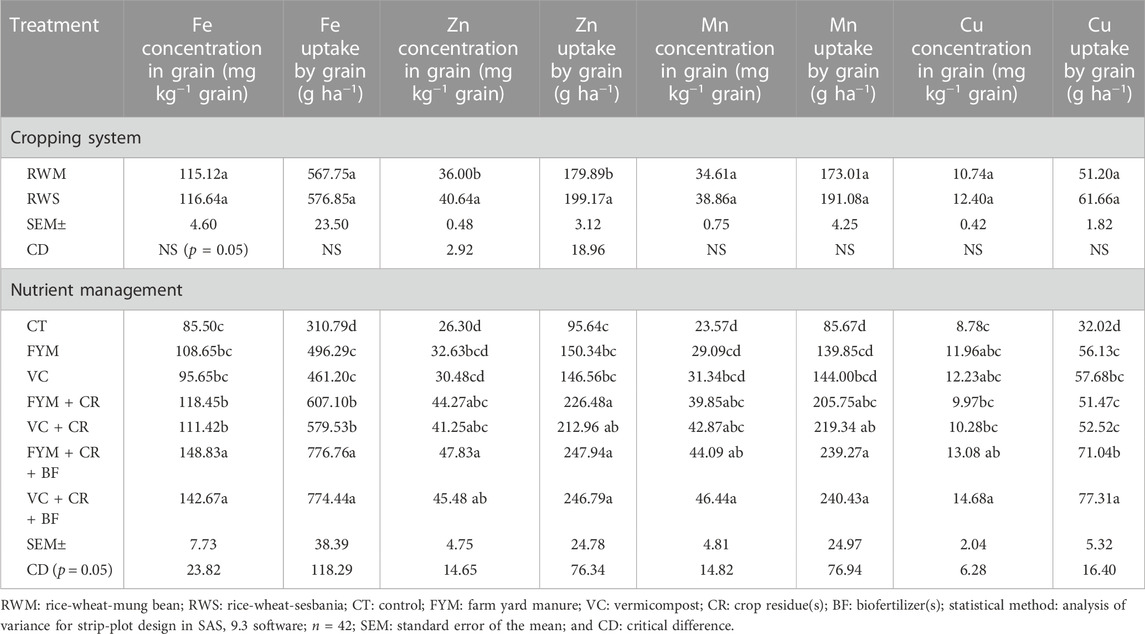
TABLE 4. Long-term effect of cropping systems and organic nutrient management on yield attributes and yield of basmati rice.
3.14 Correlation matrix
Significant (p ≤ 0.01 and p ≤ 0.001) correlations were registered among most of the soil and grain quality parameters (Tables 5, 6). Soil pH was significantly (p ≤ 0.001) and negatively correlated with grain yield (r = −0.54***), KLBC (r = −0.41***), and grain P content (r = −0.50***). Soil EC also showed significant (p ≤ 0.001) and negative correlations with grain yield, KLBC, and grain P, K, and micronutrient concentrations. Similarly, soil BD also registered a significant and negative correlation with KLBC (r = −0.47***), KBBC (r = −0.67***), and grain P concentration (r = −0.46***). The WHC and SMC were positively correlated with grain yield, KLBC, and grain Fe and Cu contents and with grain yield, KLBC, KBBC, and grain P, K, and Cu contents, respectively (Table 5). Similarly, grain yield and kernel length and breadth before cooking positively correlated with grain macro and micronutrient concentrations. SOC showed a significant (p ≤ 0.01 and p ≤ 0.001) and positive correlation with soil total N content, soil available N, P, K, Fe, Mn, and Zn contents, and grain P, K, and Cu contents (Table 6). Soil total N content positively correlated with soil available macro and micronutrients except for soil available K. A significant (p ≤ 0.01 and p ≤ 0.001) and positive correlation of soil available N and P with soil available P, K, Fe, and Mn contents, protein content, and macro and micronutrients concentrations in grain were also observed (Table 6). The soil available K also registered a significant (p ≤ 0.01 and p ≤ 0.001) and positive correlation with soil available Fe and Mn contents, grain protein content, and grain N, P, K, Fe, and Cu contents. The soil available Fe and Mn also showed a significant (p ≤ 0.01 and p ≤ 0.001) and positive correlation with grain protein content, and grain macro and micronutrient contents. We also found a significant (p ≤ 0.01 and p ≤ 0.001) and positive correlation of soil available Zn and Cu with grain protein content, grain N, P, and Cu concentrations, and grain P and Cu contents, respectively (Table 6).
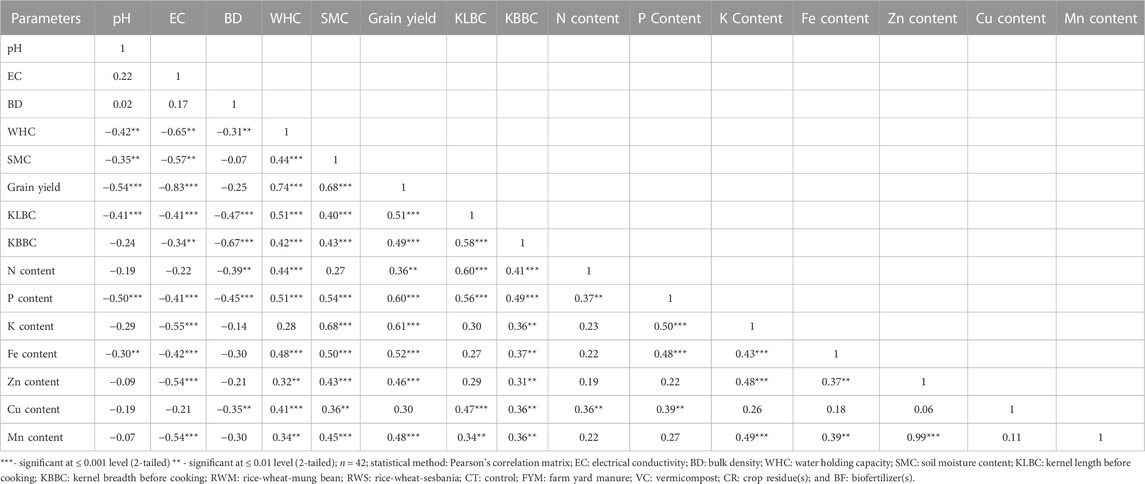
TABLE 5. Correlation matrix of different soil (pH, EC, BD, WHC, and SMC) and grain quality (KLBC, KBBC, N, P, K, Fe, Zn, Cu, and Mn contents) parameters under different cropping systems and nutrient management treatments.
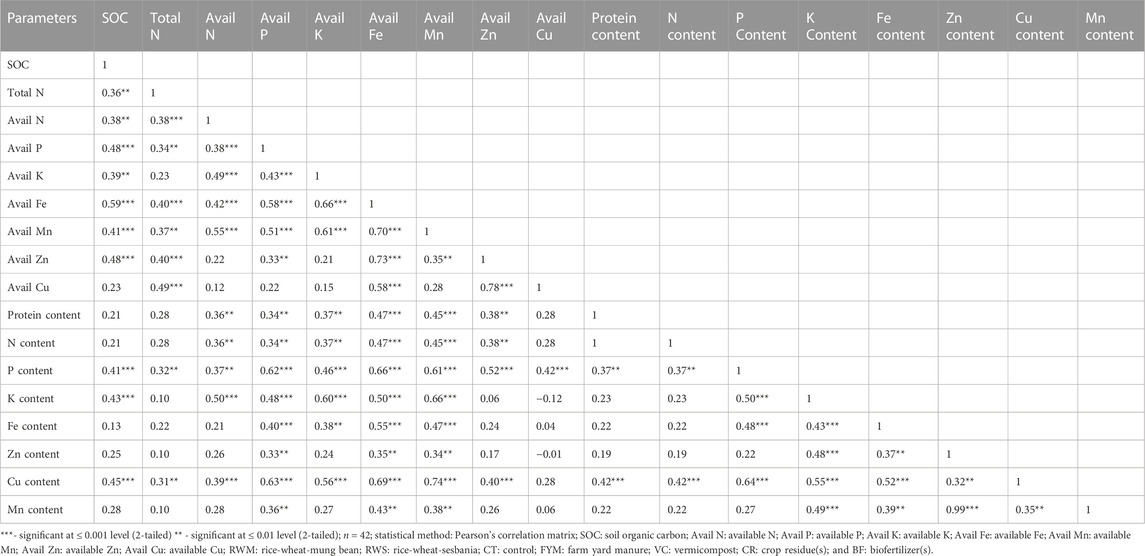
TABLE 6. Correlation matrix of different soil (SOC, total N and available N, P, K, Fe, Mn, Zn, and Cu) and grain quality (protein content and N, P, K, Fe, Zn, Cu, and Mn contents) parameters under different cropping systems and nutrient management treatments.
4 Discussion
4.1 Soil properties influenced by cropping systems and nutrient management
Soil pH, EC, BD, WHC, SMC, SOC, and soil-available macro and micronutrients are vital for facilitating a better soil environment for crop growth and producing nutritious food (Dhaliwal et al., 2019b; Gu, et al., 2022). This study showed that the inclusion of legume as green manure in basmati rice-based cropping systems and co-application of organic manures with CR and BF significantly improved the SMC, SOC, total N, and available P, Fe, Zn, Mn, and Cu contents in the soil, which affected the grain quality. The lower soil pH under the sesbania green manure-based cropping system and long-term application of organic manures might be attributed to the addition of organic matter to the soil, which enhanced microbial decomposition and subsequently produced CO2 and aromatic and aliphatic hydroxyl organic acids and thus reduced soil pH (Srinivasarao et al., 2018; Meena et al., 2020). The application of organic manures helps in buffering the soil through mineralization and decomposition of organic matter, which releases free cations and regulates the reactions in the soil (Meena et al., 2020; Yadav et al., 2021). The long-term application of organic manures in conjunction with CR and BF resulted in improved soil aggregation (Chaudhary et al., 2017). Moreover, the accumulation of organic matter in the soil also improved soil aggregation and reduced BD (Kumawat et al., 2022). Similarly, the addition of a large volume of organic matter through green manure incorporation, organic manures, and CRs resulted in higher numbers of micro and medium-sized pores, and improved infiltration, SMC, and WHC of soil (Kuotsu et al., 2014; Dhaliwal et al., 2019a). A 5-year field study carried out by Sharma et al. (2000) observed significant improvement in the WHC of soil with the application of organic manures and CRs. Further, the addition of organic matter through green manuring, FYM, VC, and CRs and their decomposition produces polysaccharides, which increase the stable and well-distributed aggregates into the soil, facilitating greater SMC and WHC of soil (Kannan et al., 2013; Yadav et al., 2020). The greater WHC in VC-comprising treatments over FYM-containing treatments showed that the type of organic manure also influences the SMC and WHC. Several researchers also documented that long-term application of FYM, VC, CR, BF, and green manure improves the number of water storage pores, soil aggregation, structure, and moisture retention capacity, and thus increases the WHC of soil (Bhattacharyya et al., 2008; Mitran et al., 2018; Meena et al., 2020; Nima et al., 2020).
SOC is an important indicator of good soil health and it regulates the physicochemical properties and biological processes of the soil (Jat et al., 2019; Babu et al., 2020a). The addition of higher organic matter through the application of C-rich organic biomass, such as green manure, FYM, VC, and CR together with BFs, increased the build-up of SOC (Chaudhary et al., 2017). The build-up of SOC in the soil is primarily determined by the carbon input through the addition of organic biomass and carbon stabilization in the soil (Babu et al., 2020a). The conjoint application of VC + CR, FYM + CR + BF, and VC + CR + BF was found superior in enhancing SOC content and SOC stock over the rest of the treatments. Our findings are corroborated by the results of Meena et al. (2020) who reported that legume-inclusive cropping systems and the continuous addition of organic manures significantly improved the SOC content in the soil. Babu et al. (2020a) also reported that the addition of higher organic biomass through organic manures increased SOC content. Moreover, the dominance of fungi and actinomycetes under anaerobic soil conditions slowed down the decomposition rates of organic matter, which led to greater SOC stock. The addition of organic material with high cellulose and lignin content, and C: N ratio together with lower microbial activities also enhanced the SOC stock in paddy soil (Meena et al., 2020). The increased accumulation of SOC content and SOC stock in soil under green manure-inclusive cropping systems and organic management practices has also been documented by many researchers (Xin et al., 2016; Dhaliwal et al., 2019a; Babu et al., 2020a; 2020b; Nima et al., 2020; Ansari et al., 2022).
Our results indicate that the addition of organic manures significantly improved the availability of macro and micronutrients in the soil. The amount of organic and inorganic fractions of N added through different organic materials and their mineralization rate determine the availability of N in the soil (Meena et al., 2020). The increased microbial-mediated transformation of organically bound N into inorganic forms led to increased availability of N in the soil in the treatments comprising organic manures, CRs, and BFs. The solubilization of native phosphate by organic acids produced during microbial decomposition of organic matter under green manure and organic manure amended treatments enhanced the availability of P and K in the soil (Solaiman et al., 2012; Nima et al., 2020; Yadav et al., 2021). Further, the formation of the protective layer of sesquioxide by the addition of higher organic matter lowers the P and K fixation in the soil and thus enhances their availability (Nagar et al., 2016; Kumawat et al., 2022). The direct addition of N, P, and K through the sole or combined application of organic nutrient sources in an active pool of soil may lead to increased total N and availability of N, P, and K in the soil (Babu et al., 2020a; Nima et al., 2020). Our results are corroborated by many previous studies that reported higher N, P, and K contents in organically managed soils under varied agro-climatic conditions (Sharma et al., 2005; Aulakh et al., 2016; Dhaliwal et al., 2019b; Jat et al., 2019). Similarly, the improved availability of DTPA extractable Fe, Zn, Mn, and Cu under legume-inclusive cropping systems and organic nutrient sources comprising treatments could be ascribed to lower soil pH and higher organic matter that developed reduced soil conditions and released CO2 and organic acids. The increased microbial activities also enhanced the micronutrient availability in the soil under legume-inclusive cropping systems and organically amended treatments (Nima et al., 2020). In addition, the amount of organic biomass added to the soil was higher under the RWS system than in the RWM system which led to increased availability of micronutrients under the sesbania green manure-based cropping system. The increased availability of Fe and Zn under FYM comprising treatments over VC-based treatments might be attributed to a higher concentration of Fe and Zn in FYM than that of VC. The higher concentration of Mn and Cu in VC than in FYM resulted in increased availability of these nutrients under VC comprising treatments. Moreover, the higher micronutrient content under long-term application of organic manures could be ascribed to enhanced biochemical processes, which led to improved mineralization of organic matter, decreased redox potential, and improved soil environment (Chaudhary and Narwal, 2005; Sidhu and Sharma, 2010; Agegnehu et al., 2016; Moharana et al., 2017).
4.2 Crop productivity, grain quality, and nutrients concentration in grain
Crop yield is a key indicator that reflects improvement in soil health (Gu et al., 2022). The present study showed the superiority of the sesbania green manure inclusive cropping system and conjoint application of various organic nutrient sources over their sole use as well as over the control. The improved soil physical properties under green manure and organic nutrient management developed a better soil environment for crop growth and development, which in turn resulted in higher grain yield of rice (Sharma et al., 2021). The continuous application of FYM and VC alone or in combination with CR and BF reduced the soil pH, EC, and BD and improved the WHC and SMC in the soil, which created favorable soil conditions for the absorption of essential nutrients, translocation, and their utilization thereby producing more biomass and resulting in increased crop productivity over the control (Meena et al., 2020). Moreover, the induced microbial activities and faster process of mineralization of organic matter increased the availability of necessary nutrients during the crop growth period (Srinivasarao et al., 2018). The improved N fixation, an increased supply of essential plant nutrients including macro and micronutrients, and improved overall soil health due to the addition of green manure, FYM, CR, and VC into the soil led to higher grain yield of basmati rice (Banik et al., 2006; Aulakh et al., 2016; Neema et al., 2020).
Agronomic management, such as cropping systems and organic nutrient management, can alter the above and below-ground environment and thus, can affect the grain quality of crops (Nayak et al., 2017). The kernel length, breadth, length:breadth ratio before and after cooking, and protein content in grain were significantly improved under the sesbania green manure-based cropping system and integrated nutrient management options. The increase in kernel length and breadth before and after cooking could be attributed to the increased availability of macro and micronutrients in the soil and their uptake and translocation due to the application of nutrient-rich organic manure and the incorporation of organic manures (Shivay and Prasad, 2012; Nayak et al., 2017). The ensured and synchronized supply of essential nutrients in proper quantity at critical growth stages of the crop through the continuous application of organic nutrient sources resulted in improved kernel length and breadth before as well as after cooking (Davari and Sharma, 2010; Pooniya and Shivay, 2015).
The grain protein content is known as an important factor for measuring the nutritional quality of basmati rice grain. The incorporation of green manure and conjoint application of different organic nutrient sources significantly improved the protein content in rice grains. The increased protein content in the sesbania green manure-based cropping system and organic nutrient management options could be attributed to increased N supply and its uptake during critical periods of crop growth and development (Guet al., 2015; Dhillon et al., 2018). Further, the increased protein content in grain is associated with the application of N-intensive and easily decomposable and mineralizable organic nutrient sources (Dhaliwal et al., 2019b). The increased availability, absorption, and translocation of N induce the transformation of photosynthates into protein, as N had a significant effect on grain protein content (Aulakh et al., 2016; Meena et al., 2022). Rao et al. (2006) also reported that a continuous supply of N together with increased uptake and assimilation by plants under organically amended treatments resulted in higher protein content in rice grains.
Physical grain qualities hulling, milling, and HRR are also important parameters that reflect soil fertility status. This study showed significant improvement in hulling, milling, and HRR of basmati rice under sesbania green manure-based cropping systems and varied organic nutrient sources. The increased uptake and mobilization of nutrients, especially N, under sesbania green manure-based cropping systems and different organic nutrient sources resulted in improved hulling, milling, and HRR of basmati rice grains (Nayak et al., 2017; Meena et al., 2022). Further, the increased physical quality of rice grains might be attributed to increased N concentration in grains, which in turn increased the protein content and reduced the breakage loss of grains. The higher concentration of protein in grains imparts strength to grains, which leads to higher HRR and other recoveries (Pooniya and Shivay, 2015). In addition, the increased availability and uptake of P, K, and micronutrients with the incorporation of the sesbania green manure and continuous application of organic nutrient sources also contributed to increased hulling, milling, and HRR of rice grains over the control.
Nutrient concentrations and their uptake by crops are the primary basis to determine the nutritional quality of food grains and the fertility status of the soil. The continuous incorporation of sesbania green manure and the addition of organic nutrient sources either alone or in combination with CR and BF aggravated the rate of N mineralization and produced varied nitrogenous compounds viz., amino acids, nitrate-N, ammoniacal-N, etc., into the soil, which increased the uptake of N and N concentration in rice grains (Didawat et al., 2022). The decomposition of organic matter releases different organic acids, such as oxalic acid, citric acid, and tartaric acid, which may increase inorganic P in the rhizosphere and thus increase P uptake and P content in rice grain (Zhao et al., 2020). It has been reported that organic acids also enhance mineral weathering and induce K solubilization and mobilization (Li et al., 2019). Moreover, the build-up of nutrients reservoirs under long-term sesbania-based cropping systems and conjoint application of organic nutrient sources increased crop growth and root proliferation, which resulted in greater uptake and concentration of N, P, and K in the rice grain (Didawat et al., 2022). The higher N, P, and K concentrations in grain and their uptake with the incorporation of green manure and combined application of organic nutrient sources might be due to increased N fixation, P and K solubilization, and mobilization of higher amounts of nutrients in rapidly available form. The enhanced availability of nutrients in the root zone led to increased crop growth and biomass production, which resulted in higher nutrient uptake and concentration in grain (Shivay et al., 2015; Jat et al., 2019). Yadav et al. (2020) reported that sesbania green manuring improved the physicochemical properties of soil and increased the nutrient availability in the soil, which led to a higher concentration of nutrients in grain and their uptake by wheat. Our findings are in agreement with the results of (Pooniya and Shivay, 2015; Singh and Shivay, 2016; Yadav et al., 2018).
Micronutrient concentrations in grain and their uptake by rice were found significantly higher with the continuous incorporation of sesbania green manure and application of organic manures in conjunction with CR and BF over the control. This might be because the long-term application of organic manures improved the soil’s physical properties, changed soil reactions, and increased nutrient solubility and available nutrient stock, enabling greater uptake and concentration of micronutrients in rice grains (Didawat et al., 2022). Further, the increased soil organic matter influenced the availability of micronutrients and their uptake by crops due to the chelation of micronutrients, which improved the root-accessible forms of these nutrients and avoided the formation of insoluble forms such as carbonates and oxides in the soil (Dhaliwal et al., 2019b). Moreover, the synergistic effect between macro and micronutrients, the uninterrupted and increased supply of nutrients led to higher nutrient uptake and their concentrations in grain (Kumar et al., 2017). Our results are corroborated by the findings by Soni et al. (2000) and Singh and Ram, (2005) who reported higher micronutrient concentration under green manure incorporation and application of organic manures. Yadav et al. (2018) reported that adequate SMC increased nutrient solubility and availability, and enhanced the micronutrient concentration in grain and their uptake by wheat. An increase in Fe, Zn, Mn, and Cu concentrations in grain due to the addition of organic manures and the inclusion of legumes in rice-wheat cropping systems has also been reported by Dhaliwal et al. (2019a).
5 Conclusion
The importance of healthy soil to produce nutritious food is globally accepted by the scientific community. The long-term incorporation of sesbania green manure and conjoint application of organic manures with CR and BF improved the soil physicochemical properties, namely, soil pH, EC, BD, SMC, and WHC. The addition of higher organic matter also increased SOC, SOC stock, and available macro and micronutrients in the soil. The use of organic sources improved the soil physicochemical properties, SOC, and availability of nutrients which in turn increased the grain yield, kernel quality, protein content, and macro and micronutrient content in grain and their uptake by basmati rice. Soil properties and grain quality are related to each other and are important indicators of soil health. This study indicates that the inclusion of sesbania as green manure and the continuous application of organic manures in the intensive rice-wheat system is a sustainable and environment-friendly agronomic approach to maintaining soil fertility and producing nutritious food for human consumption.
Data availability statement
The original contributions presented in the study are included in the article/Supplementary Material, further inquiries can be directed to the corresponding authors.
Author contributions
AK: Investigation, data analysis, and original draft writing. DK: Conceptualization, methodology, and editing. YS: Investigation and editing. AB, IR, DY, and AK: Review and editing. All authors contributed to the manuscript revision, and read and approved the submitted version.
Funding
The present study was conducted as a part of Ph.D. research work. The financial support to conduct this research was provided by the ICAR-Indian Agricultural Research Institute Indian, New Delhi, India as an Institute-funded project.
Acknowledgments
The authors are thankful to the Division of Agronomy and Division of Genetics, ICAR–Indian Agricultural Research Institute, New Delhi for providing necessary services, facilities, and supplies during the investigation. This investigation was carried out in an ongoing long-term organic field experiment “Nutrient management in rice-wheat cropping system under organic conditions” at ICAR-IARI, New Delhi, India.
Conflict of interest
The authors declare that the research was conducted in the absence of any commercial or financial relationships that could be construed as a potential conflict of interest.
Publisher’s note
All claims expressed in this article are solely those of the authors and do not necessarily represent those of their affiliated organizations, or those of the publisher, the editors and the reviewers. Any product that may be evaluated in this article, or claim that may be made by its manufacturer, is not guaranteed or endorsed by the publisher.
Supplementary material
The Supplementary Material for this article can be found online at: https://www.frontiersin.org/articles/10.3389/fenvs.2023.1031844/full#supplementary-material
SUPPLEMENTARY TABLE S1 | Cropping history of the experimental field from 2001-2021.
SUPPLEMENTARY TABLE S2 | Experimental design and treatments details.
SUPPLEMENTARY TABLE S3 | Layout of experimental design.
References
Abrahams, P. W. (2002). Soils: Their implications to human health. Sci. Total Environ. 291, 1–32. doi:10.1016/s0048-9697(01)01102-0
Agegnehu, G., Bass, A. M., Nelson, P. N., and Bird, M. I. (2016). Benefits of biochar, compost and biochar–compost for soil quality, maize yield and greenhouse gas emissions in A tropical agricultural soil. Sci. Total Environ. 543, 295–306. doi:10.1016/j.scitotenv.2015.11.054
Agyin-Birikorang, S., Tindjina, I., Adu-Gyamfi, R., Dauda, H. W., Fugice, J., and Sanabria, J. (2022). Managing essential plant nutrients to improve maize productivity in the savanna agroecological zones of northern Ghana: The role of secondary and micronutrients. J. P. Nutr., 1–20. doi:10.1080/01904167.2022.2027984
Ahmed, M., Shaheen, N., Islam, M., Habibullah-Al-Mamun, M., Islam, S., and Banu, C. P. (2015). Trace elements in two staple cereals (rice and wheat) and associated health risk implications in Bangladesh. Environ. Monit. Assess. 187, 1–11. doi:10.1007/s10661-015-4576-5
Ansari, M. A., Choudhury, B. U., Layek, J., Das, A., Lal, R., and Mishra, V. K. (2022). Green manuring and crop residue management: Effect on soil organic carbon stock, aggregation, and system productivity in the foothills of eastern himalaya (India). Soil till. Res. 218, 105318. doi:10.1016/j.still.2022.105318
Aulakh, C. S., Kaur, P., Walia, S. S., Gill, R. S., Sharma, S., and Buttar, G. S. (2016). Productivity and quality of basmati rice (oryza sativa) in relation to nitrogen management. Indian J. Agron. 61 (4), 467–473.
Babu, S., Singh, R., Avasthe, R. K., Yadav, G. S., Das, A., Singh, V. K., et al. (2020a). Impact of land configuration and organic nutrient management on productivity, quality and soil properties under baby corn in eastern himalayas. Sci. Rep. 10 (1), 16129–16214. doi:10.1038/s41598-020-73072-6
Babu, S., Singh, R., Avasthe, R. K., Yadav, G. S., Mohapatra, K. P., Selvan, T., et al. (2020b). Soil carbon dynamics in Indian himalayan intensified organic rice-based cropping sequences. Ecol. Indic 114, 106292. doi:10.1016/j.ecolind.2020.106292
Bala, K., Sood, A. K., Pathania, V. S., and Thakur, S. (2018). Effect of plant nutrition in insect pest management: A Review. J. Pharmacogn. Phytochem. 7 (4), 2737–2742.
Banik, P., Ghosal, P. K., Sasmal, T. K., Bhattacharya, S., Sarkar, B. K., and Bagchi, D. K. (2006). Effect of organic and inorganic nutrients for soil quality conservation and yield of rainfed low land rice in sub-tropical plateau region. J. Agron. Crop Sci. 192 (5), 331–343. doi:10.1111/j.1439-037x.2006.00219.x
Bhattacharyya, R., Kundu, S., Prakash, V., and Gupta, H. S. (2008). Sustainability under combined application of mineral and organic fertilizers in A rainfed soybean–wheat system of the Indian himalayas. Eur. J. Agron. 28 (1), 33–46. doi:10.1016/j.eja.2007.04.006
Bouyoucos, G. J. (1962). Hydrometer method improved for making particle size analyses of soils 1. Agron. J. 54 (5), 464–465. doi:10.2134/agronj1962.00021962005400050028x
Brevik, E. C. (2009). “Soil, food security, and human health,”, Developed under the auspices of the UNESCO in Encyclopedia ofLife support systems (EOLSS). Soils,Plant Growth and Crop Production, Editor W. Verheye (Oxford: EOLSS Publishers).
Brevik, E. C., Slaughter, L., Singh, B. R., Steffan, J. J., Collier, D., Barnhart, P., et al. (2020). Soil and human health: Current status and future needs. Air, Soil Water Res. 13,117862212093444–23. doi:10.1177/1178622120934441
Cakmak, I. (2008). Enrichment of cereal grains with zinc: Agronomic or genetic Biofortification?Plant soil. Plant Soil 302 (1), 1–17. doi:10.1007/s11104-007-9466-3
Chaudhary, M., and Narwal, R. P. (2005). Effect of long-term application of farmyard manure on soil micronutrient status. Arch. Agron. Soil Sci. 51 (3), 351–359. doi:10.1080/03650340500133134
Chaudhary, S., Dheri, G. S., and Brar, B. S. (2017). Long-term effects of NPK fertilizers and organic manures on carbon stabilization and management index under rice-wheat cropping system. SoilTill. Res. 166, 59–66. doi:10.1016/j.still.2016.10.005
Datta, A., Basak, N., Chaudhari, S. K., and Sharma, D. K. (2015). Soil properties and organic carbon distribution under different land uses in reclaimed sodic soils of north-west India. Geoderma Reg. 4, 134–146. doi:10.1016/j.geodrs.2015.01.006
Davari, M. R., and Sharma, S. N. (2010). Effect of different combinations of organic materials and biofertilizers on productivity, grain quality and economics in organic farming of basmati rice (oryza sativa). Indian J. Agron. 55 (4), 290–294.
Detterbeck, A., Pongrac, P., Rensch, S., Reuscher, S., Pečovnik, M., Vavpetič, P., et al. (2016). Spatially resolved analysis of variation in barley (hordeum vulgare) grain micronutrient accumulation. New Phytol. 211 (4), 1241–1254. doi:10.1111/nph.13987
Dhaliwal, S. S., Naresh, R. K., Mandal, A., Singh, R., and Dhaliwal, M. K. (2019b). Dynamics and transformations of micronutrients in agricultural soils as influenced by organic matter build-up: A Review. Environ. Sustain. Indic. 1, 100007. doi:10.1016/j.indic.2019.100007
Dhaliwal, S. S., Naresh, R. K., Mandal, A., Walia, M. K., Gupta, R. K., Singh, R., et al. (2019a). Effect of manures and fertilizers on soil physical properties, build-up of macro and micronutrients and uptake in soil under different cropping systems: A Review. J. Plant Nutr. 42 (20), 2873–2900. doi:10.1080/01904167.2019.1659337
Dhaliwal, S. S., and Walia, S. S. (2008). Integrated nutrient management for sustaining maximum productivity ofRice-wheat system under Punjab conditions. J. Res. PAU 45, 12–16.
Dhillon, A. K., Sharma, N., Dosanjh, N. K., Goyal, M., and Mahajan, G. (2018). Variation in the nutritional quality of rice straw and grain in response to different nitrogen levels. J. Plant Nutr. 41 (15), 1946–1956. doi:10.1080/01904167.2018.1482915
Didawat, R. K., Sharma, V. K., Nath, D. J., Patra, A., Kumar, S., Biswas, D. R., et al. (2022). Soil biochemical properties and nutritional quality of rice cultivated in acidic inceptisols using long-term organic farming practices. Arch. Agron. Soil Sci. 1–16. doi:10.1080/03650340.2022.2084084
Fukagawa, N. K., and Ziska, L. H. (2019). Rice: Importance for global nutrition. J. Nutr. Sci. Vitaminol. 65, S2–S3. doi:10.3177/jnsv.65.s2
Gu, J., Chen, J., Chen, L., Wang, Z., Zhang, H., and Yang, J. (2015). Grain quality changes and responses to nitrogen fertilizer of japonica rice cultivars released in the yangtze river basin from the 1950s to 2000s. Crop J. 3 (4), 285–297. doi:10.1016/j.cj.2015.03.007
Gu, W., Wang, Y., Feng, Z., Wu, D., Zhang, H., Yuan, H., et al. (2022). Long-term effects of biochar application with reduced chemical fertilizer on paddy soil properties and japonica rice production system. Front. Environ. Sci. 742, 902752. doi:10.3389/fenvs.2022.902752
Hartge, K. H., and Blake, G. R. (1986). Bulk density. Methods of soil analysis. 2nd ed. Madison, Wisconsin: American Society of Agronomy, Crop Science Society of America and Soil Science Society of America, 363–382. Part 1.
Huang, S., Wang, P., Yamaji, N., and Ma, J. F. (2020). Plant nutrition for human nutrition: Hints from rice research and future perspectives. Plant 13 (6), 825–835. doi:10.1016/j.molp.2020.05.007
Jat, H. S., Datta, A., Choudhary, M., Sharma, P. C., Yadav, A. K., Choudhary, V., et al. (2019). Climate smart agriculture practices improve soil organic carbon pools, biological properties and crop productivity in cereal-based systems of north-west India. Catena 181, 104059. doi:10.1016/j.catena.2019.05.005
Juliano, B. O. (1985). Polysaccharides, proteins and lipids of rice. In rice: Chemistry and technology. InternationalRice Research Institute: Los Banos, Laguna, Philippines, 98
Kannan, R. L., Dhivya, M., Abinaya, D., Krishna, R. L., and Krishnakumar, S. (2013). Effect of integrated nutrient management on soil fertility and productivity in maize. Bull. Env. Pharmacol. Life Sci. 2 (8), 61–67.
Keen, B. A., and Raczkowski, H. (1921). The relation between the clay content and certain physical properties of A soil. J. Agric. Sci. 11 (4), 441–449. doi:10.1017/s0021859600004469
Khanam, R., Kumar, A., Nayak, A. K., Shahid, M., Tripathi, R., Vijayakumar, S., et al. (2020). Metal (loid) s (as, Hg, Se, Pb and Cd) in paddy soil: Bioavailability and potential risk to human health. Sci. Total Environ. 699, 134330. doi:10.1016/j.scitotenv.2019.134330
Kibblewhite, M. G., Ritz, K., and Swift, M. J. (2008). Soil health in agricultural systems. Philos. Trans. R. Soc. B Biol. Sci. 363 (1492), 685–701. doi:10.1098/rstb.2007.2178
Kumar, A., Sen, A., Upadhyay, P. K., and Singh, R. K. (2017). Effect of zinc, iron and manganese levels on quality, micro and macro nutrients content of rice and their relationship with yield. Commun. Soil Sci. Plant Anal. 48 (13), 1539–1551. doi:10.1080/00103624.2017.1373799
Kumawat, A., Vishwakarma, A. K., Wanjari, R. H., Sharma, N. K., Yadav, D., Kumar, D., et al. (2022). Impact of levels of residue retention on soil properties under conservation agriculture in vertisols of central India. Arch. Agron. Soil Sci. 68 (3), 368–382. doi:10.1080/03650340.2020.1836345
Kuotsu, K., Das, A., Lal, R., Munda, G. C., Ghosh, P. K., and Ngachan, S. V. (2014). Land forming and tillage effects on soil properties and productivity of rainfed groundnut (Arachis hypogaea L.)–Rapeseed (Brassica campestris L.) cropping system in northeastern India. Soil till. Res. 142, 15–24. doi:10.1016/j.still.2014.04.008
Li, Z. B., Lu, X., Teng, H. H., Chen, Y., Zhao, L., Ji, J., et al. (2019). Specificity of low molecular weight organic acids on the release of elements from lizardite during fungal weathering. Geochim. Cosmochim. Acta 256, 20–34. doi:10.1016/j.gca.2018.09.029
Lindsay, W. L., and Norvell, W. (1978). Development of a DTPA soil test for zinc, iron, manganese, and copper. Soil sci.soc. Am.J. 42 (3), 421–428. doi:10.2136/sssaj1978.03615995004200030009x
Meena, A. L., Pandey, R. N., Kumar, D., Dotaniya, M. L., Sharma, V. K., Singh, G., et al. (2020). Impact of 12-year-long rice based organic farming on soil quality in terms of soil physical properties, available micronutrients and rice yield in A typic Ustochrept soil of India. Commun. Soil Sci. Plant Anal. 51 (18), 2331–2348. doi:10.1080/00103624.2020.1822386
Meena, R. K., Singh, Y. V., Shivay, Y. S., Kumar, D., Kumar, R., Ram, H., et al. (2022). Rice performance as influenced by crop establishment methods, green organic mulches and rates of nitrogen fertilization along with liquid azotobacter chroococcum. J. Plant Nutr., 1–22. doi:10.1080/01904167.2022.2068440
Mitran, T., Kumar, P., Bandyopadhyay, P. K., and Basak, N. (2018). Effects of organic amendments on soil physical attributes and aggregate-associated phosphorus under long-term rice-wheat cropping. Pedosphere 28 (5), 823–832. doi:10.1016/s1002-0160(17)60423-5
Moharana, P. C., Sharma, B. M., and Biswas, D. R. (2017). Changes in the soil properties and availability of micronutrients after six-year application of organic and chemical fertilizers using STCR-based targeted yield equations under pearl millet-wheat cropping system. J. Plant Nutr. 40 (2), 165–176. doi:10.1080/01904167.2016.1201504
Myers, S. S., Zanobetti, A., Kloog, I., Huybers, P., Leakey, A. D., Bloom, A. J., et al. (2014). Increasing CO2 threatens human nutrition. Nature 510 (7503), 139–142. doi:10.1038/nature13179
Nagar, R. K., Goud, V. V., Kumar, R., and Kumar, R. (2016). Effect of organic manures and crop residue management on physical, chemical and biological properties of soil under pigeonpea based intercropping system. Int. J. Farm Sci. 6 (1), 101–113.
Nayak, R., Paikaray, R. K., Sahoo, T. R., Lal, M. K., and Kumar, A. (2017). Yield, quality and economics of basmati rice as influenced by different organic nutrient management practices. Oryza 54(1), 44–49.
Nima, D., Aulakh, C. S., Sharma, S., and Kukal, S. S. (2020). Assessing soil quality under long-term organic vis-A-vis chemical farming after twelve years in north-western India. J. Plant Nutr. 44, 1175–1192. doi:10.1080/01904167.2020.1862195
Oliver, M. A., and Gregory, P. J. (2015). Soil, food security and human health: A Review. Eur. J. Soil Sci. 66 (2), 257–276. doi:10.1111/ejss.12216
Olsen, S. R., Cole, C. V., Watanabe, F. S., and Dean, L. A. (1954). Estimation of available phosphorus in soils by extracting with sodium bicarbonate. United State Dep. Agric. Circular No. 939.
Pirzadeh, M., Afyuni, M., Khoshgoftarmanesh, A., and Schulin, R. (2010). Micronutrient status of calcareous paddy soils and rice products: Implication for human Health.Biol. Fertil. Soils 46, 317–322. doi:10.1007/s00374-009-0428-1
Pooniya, V., and Shivay, Y. S. (2015). Influence of green manuring and zinc fertilization on quality parameters of basmati rice. Commun. Soil Sci. Plant Anal. 46 (3), 382–392. doi:10.1080/00103624.2014.981275
Prasad, R., Shivay, Y. S., Kumar, D., and Sharma, S. N. (2006). Learning by doing exercises in soil fertility (A practical manual for soil fertility). Div. Agron. IARI, New Delhi 68.
Rao, S. A. V., Prasad, P. V. N., and Venkateswarlu, B. (2006). Synergistic influence of nitrogen and zinc on grain yield and quality of rice (oryza sativa L.). In proceedings of national symposium on conservation agriculture and environment(pp. 26–28).
Rutkowska, B., Szulc, W., Sosulski, T., and Stępień, W. (2014). Soil micronutrient availability to crops affected by long-term inorganic and organic fertilizer applications. Plant Soil Environ. 60 (5), 198–203. doi:10.17221/914/2013-pse
Sharma, M. P., Bali, S. Y., and Gupta, D. K. (2000). Crop yield and properties of inceptisol as influenced by residue management under rice-wheat cropping sequence. J. Indian Soc. Soil Sci. 48(3), 506–509.
Sharma, R. P., Sharma, A., and Sharma, J. K. (2005). Productivity, nutrient uptake, soil fertility and economics as affected by chemical fertilizers and farmyard manure in broccoli (Brassica oleracea var italica) in an entisol. Indian J. agric.sci. 75(9), 576–579.
Sharma, S., Singh, P., Choudhary, O. P., and Neemisha, (2021). Nitrogen and rice straw incorporation impact nitrogen use efficiency, soil nitrogen pools and enzyme activity in rice-wheat system in north-western India. Field Crops Res. 266, 108131. doi:10.1016/j.fcr.2021.108131
Shivay, Y. S., and Prasad, R. (2012). Zinc-coated urea improves productivity and quality of basmati rice (oryza sativa L.) under zinc stress condition. J. Plant Nutr. 35 (6), 928–951. doi:10.1080/01904167.2012.663444
Shivay, Y. S., Prasad, R., and Pal, M. (2015). Effects of source and method of zinc application on yield, zinc biofortification of grain, and Zn uptake and use efficiency in chickpea (cicer arietinum L.). Commun. Soil Sci. Plant Anal. 46, 2191–2200. doi:10.1080/00103624.2015.1069320
Shrestha, J., Kandel, M., Subedi, S., and Shah, K. K. (2020). Role of nutrients in rice (oryza sativa L.): A Review. Agrica 9 (1), 53–62. doi:10.5958/2394-448x.2020.00008.5
Sidhu, G. S., and Sharma, B. D. (2010). Diethylenetriaminepentaacetic acid–extractable micronutrients status in soil under a rice–wheat system and their relationship with soil properties in different agroclimatic zones of indo-gangetic plains of India. Commun. Soil Sci. Plant Anal. 41 (1), 29–51. doi:10.1080/00103620903360262
Singh, A., and Shivay, Y. S. (2016). Effect of summer green manuring crops and zinc fertilizer sources on productivity, Zn-uptake and economics of basmati rice. J. Plant Nutr. 39 (2), 204–18. doi:10.1080/01904167.2015.1009108
Singh, V., and Ram, N. (2005). Effect of 25 Years of continuous fertilizer use on response to applied nutrients and uptake of micronutrients by rice-wheat-cowpea system. Cereal Res. Commun. 3, 589–594. doi:10.1556/crc.33.2005.2-3.124
Solaiman, Z. M., Murphy, D. V., and Abbott, L. K. (2012). biochars influence seed germination and early growth of seedlings. Plant Soil 353 (1-2), 273–87. doi:10.1007/s11104-011-1031-4
Soni, M. L., Swarup, A., and Singh, M. (2000). Effect of manganese and phosphorus application on yield and nutrition of wheat in reclaimed sodic soil. Curr. Agric. 24(1/2), 105–109.
Srinivasarao, C., Kundu, S., Sharma, K. L., Thakur, P. B., Amrutsagar, V. M., Deshpande, A. N., et al. (2018). Effect of 22-year-long conjunctive use of organic and chemical sources of nutrients on crop yield, soil properties, and nutrient balance in post-monsoon sorghum (sorghum bicolor L.) in peninsular vertisols of India. Commun. Soil Sci. Plant Anal. 49, 1570–1585. doi:10.1080/00103624.2018.1474897
Steffan, J. J., Brevik, E. C., Burgess, L. C., and Cerdà, A. (2018). The effect of soil on human health: An overview. Eur.J. Soil Sci. 69 (1), 159–171. doi:10.1111/ejss.12451
Subbiah, B. V., and Asija, G. L. (1956). A rapid procedure for the determination of available nitrogen in Soils. Curr.Sci. 25, 259–260.
Walkley, A., and Black, I. A. (1934). An examination of the different method for determining soil organic matter, and A proposed modification of the chromic acid titration method. Soil Sci. 37 (1), 29–38. doi:10.1097/00010694-193401000-00003
Welch, R. (2002). The impact of mineral nutrients in food crops on global human health. Plant Soil 247, 83–90. doi:10.1023/a:1021140122921
Xin, X., Zhang, J., Zhu, A., and Zhang, C. (2016). Effects of long-term (23 Years) mineral fertilizer and compost application on physical properties of fluvo-aquic soil in the north China plain. Soil till. Res. 156, 166–172. doi:10.1016/j.still.2015.10.012
Yadav, D., Shivay, Y. S., Singh, Y. V., Sharma, V. K., and Bhatia, A. (2020). Enhancing nutrient translocation, yields and water productivity of wheat under rice–wheat cropping system through zinc nutrition and residual effect of green manuring. J. Plant Nutr. 43 (19), 2845–2856. doi:10.1080/01904167.2020.1798997
Yadav, D., Shivay, Y. S., Singh, Y. V., Sharma, V. K., and Bhatia, A. (2018). Yield attributes, yields and nutrient uptake of basmati rice (oryza sativa) as influenced by in-situ and ex-situ green manuring crops and zinc fertilization. Indian J. Agric. Sci. 88 (5), 671–678.
Yadav, D., Vishwakarma, A. K., Sharma, N. K., Biswas, A. K., Ojasvi, P. R., Kumar, D., et al. (2021). Sustaining the properties of Black soil in central India through crop residue management in A conservation-agriculture-based soybean–wheat system. Land Degrad. Dev. 32 (10), 2906–2921. doi:10.1002/ldr.3891
Zhao, Z., Zhang, C., Li, F., Gao, S., and Zhang, J. (2020). Effect of compost and inorganic fertilizer on organic carbon and activities of carbon cycle enzymes in aggregates of an intensively cultivated vertisol. Plos One 15, e0229644. doi:10.1371/journal.pone.0229644
Zhu, C., Kobayashi, K., Loladze, I., Zhu, J., Jiang, Q., Xu, X., et al. (2018). Carbon dioxide (CO2) levels this century will alter the protein, micronutrients, and vitamin content of rice grains with potential health consequences for the poorest rice-dependent countries. Sci. Adv. 4, eaaq1012. doi:10.1126/sciadv.aaq1012
Keywords: basmati rice, grain quality, micronutrients, organic nutrient management, soil health
Citation: Kumawat A, Kumar D, Shivay YS, Bhatia A, Rashmi I, Yadav D and Kumar A (2023) Long-term impact of biofertilization on soil health and nutritional quality of organic basmati rice in a typic ustchrept soil of India. Front. Environ. Sci. 11:1031844. doi: 10.3389/fenvs.2023.1031844
Received: 30 August 2022; Accepted: 21 February 2023;
Published: 08 March 2023.
Edited by:
Ganga M. Hettiarachchi, Kansas State University, United StatesReviewed by:
Agnieszka Klimkowicz-Pawlas, Institute of Soil Science and Plant Cultivation, PolandLinda S. Lee, Purdue University, United States
Copyright © 2023 Kumawat, Kumar, Shivay, Bhatia, Rashmi, Yadav and Kumar. This is an open-access article distributed under the terms of the Creative Commons Attribution License (CC BY). The use, distribution or reproduction in other forums is permitted, provided the original author(s) and the copyright owner(s) are credited and that the original publication in this journal is cited, in accordance with accepted academic practice. No use, distribution or reproduction is permitted which does not comply with these terms.
*Correspondence: Anita Kumawat, YWt1bWF3YXQzMzNAZ21haWwuY29t; Dinesh Kumar, ZGluZXNoY3R0QHlhaG9vLmNvbQ==
 Anita Kumawat
Anita Kumawat Dinesh Kumar
Dinesh Kumar Y. S. Shivay1
Y. S. Shivay1 Arti Bhatia
Arti Bhatia Devideen Yadav
Devideen Yadav